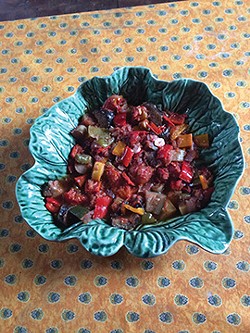Farm kitchens are usually envisioned as large, warm and welcoming, but the folks who’d built our house more than 150 years ago didn’t share that vision. The kitchen was too small for even a four-top table. Worse, it had been remodeled in the 60s with hot-pink Formica countertops, headache-inducing wallpaper with stylized hot-pink and avocado daisies and avocado carpeting, now quite worn.
We replaced the countertops and wallpaper, but as unexpected expenses kept popping up (It quickly became obvious that the definition of “historic” is “needs regular infusions of large amounts of cash”), we decided to delay new flooring. Actually, my husband, Peter, was fine with keeping the dismal carpeting for a while; I only reluctantly agreed.
It was late summer, the perfect time to make a big batch of ratatouille. As I carried the huge pottery bowl, filled to the brim, from the stove to the counter, I tripped, spilling the steaming, fragrant mass onto the ugly carpet and breaking the bowl. I yelled for reinforcements. The kids and I shoveled up the mess; I spent hours futilely trying to clean the disgusting carpet. I’d always known that I was an industrial-flooring-with-a-drainpipe-so-the-floor-can-be-hosed-down cook rather than a kitchen-carpeting kind of cook; that had been an even more important reason to me for replacing it than its ugliness. Now it was confirmed. New kitchen flooring moved to the top of our priority list.
To this day, Peter still half suspects that I spilled the ratatouille on purpose to get a new floor. But I can offer two facts that provide what I consider irrefutable proof that it was an accident: 1) The pottery bowl I broke was a favorite, unique and irreplaceable. I had plenty of other bowls and pots that would have done the trick just as well; I would never have deliberately broken (or risk breaking) that bowl. 2) I’d made a quadruple batch of ratatouille, intending to freeze most of it for the winter. It wouldn’t have taken the entire amount to ruin the carpet – half would have worked nicely. Some could have been held back, and my efforts in making it wouldn’t have been entirely in vain.
Ratatouille is a peasant dish. It’s from Provence, in southern France. As with many classics, there are as many versions as there are cooks, although the basic ingredients are constant: tomatoes, zucchini, onion, eggplant, pepper, garlic and herbs.
Most traditional ratatouille recipes call for all of the ingredients to be thrown into a pot at once. They usually also call for almost constant stirring. “The most important thing in making ratatouille is stir, stir, STIR,” said one of the first recipes I tried.
The problem is that if the stew is simmered just long enough for the vegetables to be cooked through but still retain some semblance of individuality, it’s watery; if cooked down to the traditional stew (stir, stir STIR), softer vegetables such as zucchini lose color and become mushy. The end product may be wonderfully tasty but looks unappealing.
I’m quite proud of the recipe below. I tinkered with ratatouille for years before coming up with the method, which melds the ingredients into a stew-like consistency without sacrificing each vegetable’s identity. It freezes well for a taste of summer in colder months. Ratatouille has many uses beyond its traditional role as a first course or side dish; having portions available in the freezer is one of the things I most depend on to be able to make tasty meals without much fuss. It makes a wonderful pasta condiment (use a sturdy pasta shape such as rigatoni). You could add some crumbled Italian sausage if you like but it’s certainly not necessary. In the same vein, substitute it for tomato sauce to make different and exceptionally delicious lasagna. It can also be used as a condiment in submarine-type sandwiches. Or how about eggs ratatouille? Its savory goodness is equally suitable for breakfast, brunch or supper: Plan on about 1/2 – 3/4 cup ratatouille per serving if using one egg per person; 3/4 – 1 cup for two eggs. Spread an approximately inch-thick layer in a shallow baking dish or individual ramekins. Place in a 350 F oven until hot. (Alternatively, heat the ratatouille on the stove or in a microwave.) Remove from the oven and make as many depressions as you’ll need evenly in the sauce with the back of a large spoon or a ladle. Crack the eggs one at a time into a saucer, and then carefully slip them into the depressions. Salt and pepper to taste (just the eggs), drizzle with a little extra-virgin olive oil, scatter with grated cheese if desired, then return to the oven and bake until the whites are set and the yolks are cooked to your liking. Serve with rustic bread, grilled or toasted.
Ratatouille
• 8 c. tomatoes, peeled, seeded and chopped
• 6 c. eggplant (remove largely seeded areas), peeled or not as you prefer, cut into 1-inch cubes
• 6 c. onions, NOT super sweet, cut into 1-inch cubes
• 1/3 c. thinly sliced or chopped garlic
• 6 c. zucchini, green, yellow or mixed (remove largely seeded areas), cut into 1-inch cubes
• 6 c. bell peppers – red, green or mixed, cut into 1-inch cubes
• 4 T. extra-virgin olive oil, divided
• 3 T. chopped fresh thyme or 1 T. dried thyme leaves (NOT ground)
• 2 bay leaves
• Minced fresh hot chiles or hot-pepper flakes to taste, optional
• Salt and freshly ground pepper to taste
Mix the tomatoes with 1 tablespoon of salt and put them in a colander. Drain for 1 hour, stirring occasionally. Mix the eggplant with 1 tablespoon of salt in another colander. Drain for 1 hour. In a large skillet or wok, heat 1 tablespoon of oil over very high heat. Add the onions and stir-fry until they’re softened and lightly caramelized. (Don’t crowd the vegetables – do this in batches if your skillet isn’t big enough.) Add the garlic and cook for a couple of minutes until the garlic has softened but not browned. Put the onion-and-garlic mixture into a large heavy pot and add the drained tomatoes, bay leaves, thyme and hot peppers (if you are using them). (Hint: Make a note to yourself of how many bay leaves you’ve put in so that you can be sure how many there are to take out when the ratatouille is finished.) Place the pot over medium heat and bring the contents to a simmer, stirring frequently. Rinse the eggplant cubes and roll them in a lint-free towel. Squeeze the towel to remove as much moisture as possible. Return the skillet to the stove and add another tablespoon of oil. When hot, add the eggplant and stir-fry until it’s softened and lightly caramelized. Add the eggplant to the pot. Return the skillet to the heat, add a tablespoon of olive oil, repeat the process with the peppers, then add them to the pot. Repeat with the zucchini, but set them aside after stir-frying. Cook the mixture, stirring frequently, until it’s thickened and excess liquid has evaporated (about 20 minutes; more if you’re making multiple recipes’ worth). Adjust the heat to avoid scorching. Add the zucchini, reduce heat to low and cook for another five minutes.
Season to taste with salt and pepper. Remove the bay leaves. Serve warm or at room temperature. The ratatouille is wonderful served immediately, but, as is true with most stews, even better the next day.
Makes about 12 cups.
Contact Julianne Glatz at [email protected].
Ratatouille
[
{
"name": "Air - MedRect Combo - Inline Content 1",
"component": "11490391",
"insertPoint": "3",
"requiredCountToDisplay": "1",
"parentWrapperClass": "fdn-ads-inline-content-block"
},{
"name": "Air - MedRect Combo - Inline Content 2",
"component": "11490392",
"insertPoint": "7",
"requiredCountToDisplay": "5",
"parentWrapperClass": "fdn-ads-inline-content-block"
},{
"name": "Air - MedRect Combo - Inline Content 3",
"component": "11490393",
"insertPoint": "12",
"requiredCountToDisplay": "9",
"parentWrapperClass": "fdn-ads-inline-content-block"
}
]
Ratatouille got me my first new kitchen floor. I’m not talking about the 2007 Disney movie but the classic French vegetable stew (pronounced ra-ta-TOO-ee) that gave the movie its name. We’d moved into our historic farmhouse a month before.
Illinois Times has provided readers with independent journalism for almost 50 years, from news and politics to arts and culture.
Your support will help cover the costs of editorial content published each week. Without local news organizations, we would be less informed about the issues that affect our community..
Got something to say?
Send a letter to the editor and we'll publish your feedback in print!



















